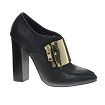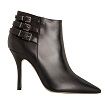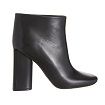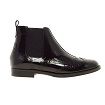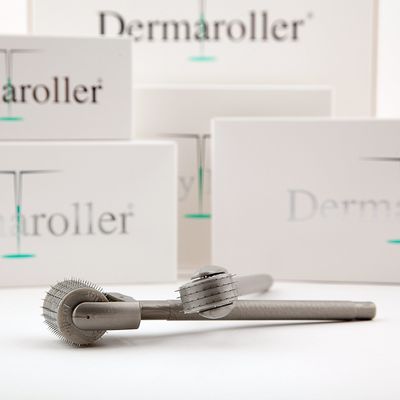
We may be horrified that our Elizabethan forebears used lead and arsenic in their beauty regimens, but future generations will certainly look back in horror at this one’s attempts to defy age. After all, injecting a deadly toxin, using chemicals to peel away layers of dermis, and shooting up our faces with synthetic fillers all sound pretty macabre. In that spirit, I decided to test out a niche anti-aging technique called microneedling, in which you repeatedly roll tiny needles all over your face, a treatment I’d first heard about a few years ago when it came out that Angelina Jolie was a fan.
Before embarking on this adventure in narcissistic masochism, I asked my own dermatologist (who does not perform the procedure) off the record if she thought it was safe. I wanted to be sure that my risk of permanent disfigurement or contracting a deadly flesh-eating bacteria was low — or, ideally, nil. She told me it’s generally safe and has some legitimate science behind it.
Microneedling is the process of punching hundreds of tiny holes in your face, causing microscopic injury to the skin, which in turn stimulates the growth of new collagen. It works sort of the same way lasers do, except mechanically rather than with heat and light. According to some studies and anecdotal clinical claims, microneedling can help minimize scarring, decrease wrinkles, and reverse photoaging.
The Dermaroller, a handheld microneedling device invented by a German scientist, hit the market in 2000, and has had a resurgence of interest here in the U.S. thanks to a new distributor. There’s an in-office version with longer needles that only trained medical staff should use, and there’s a slightly less scary home version that you can get for $149.
Originally I planned for an in-office treatment, but the Dermaroller company representative couldn’t give me the name of a single practitioner anywhere in the New York metro area. “Can you get to Madison, Wisconsin?” she asked me. Sadly, I could not, so I settled for the home version. Before trying it, I chatted with Dr. David Duffy, a dermatologist based in Torrance, California (nope, couldn’t get there either), who is a recent convert to the Dermaroller. The reason the Dermaroller may be more popular in off-the-beaten-path cities probably has a lot to do with cost.
“What I realized when I saw this device is it’s sort of the poor man’s Fraxel [laser]. It basically promotes new tissue growth, and it does it very simply, with simple trauma,” Dr. Duffy told me. “It costs a hundred grand for a Fraxel machine, but these little rollers can give you damn near the same results for next to nothing.” Dr. Duffy charges $550 for an in-office Dermaroller procedure. That’s not exactly nothing, but it’s about a third of the price of a Fraxel treatment. I spoke to Dr. Heidi Waldorf, the director of laser and cosmetic dermatology at the Mount Sinai Medical Center in New York City, for her take on my little experiment. She’s generally not a fan of the Dermaroller, though acknowledged that a lot of her colleagues in Asia and the Middle East use it because it’s cheaper than laser therapy. “The only reason I can see to use [the Dermaroller] is for cost. It doesn’t work as well. I’m going to use the thing that works best,” she told me.
In the office, Dr. Duffy applies a topical anesthetic cream, then rolls the face thoroughly in a horizontal, vertical, and diagonal pattern. Each patient receives a brand-new roller head; they can’t be sterilized and reused. The rolling process takes about 30 minutes, and can cause a bit of bleeding, redness, and a “train track” look for a day or so. You can’t wear any makeup for 24 hours after the procedure.
The needles on in-office Dermarollers range in size from 0.5mm to 2.5mm — larger needles are better for acne and burn scars, and there are currently some promising ongoing studies using the Dermaroller on burn patients. The home version’s needles are only 0.2mm and won’t produce the same collagen-inducing trauma that longer needles will. Um, then why the hell was I going to do this to myself?
There have been studies to confirm that Dermarolling can actually help topical medications penetrate more efficiently, which is why I ultimately went for it. According to Dr. Duffy, only 4 to 8 percent of that pricey serum you’re using on your face actually penetrates your skin. Poking holes in yourself helps the active ingredients get where they need to be. This is a trend with laser treatment, too. A study published last year demonstrated that when a Clear + Brilliant laser treatment is given prior to using Skinceuticals’ CE Ferulic, an antioxidant preparation, absorption increased exponentially.
I have been a loyal user of CE Ferulic for years, so I decided to try this trick with my brand-new Dermaroller. Dr. Duffy warned that patients generally have the most pain on the forehead, but I decided to roll that area first because it’s where I have the most fine lines … plus, I wanted to be able to cover it with my hair in case something went horribly wrong.
After first thoroughly cleaning and soaking the Dermaroller for hygiene purposes with the included roller cleanser, I counted 162 teeny needles. I washed my face, took a deep breath, and rolled … with caution. I stopped at only my forehead just to see what the effects would be before doing my whole face. I’d been warned by Dr. Duffy not to apply any pressure. It didn’t hurt exactly — it felt more irritating with a little burning, which increased twofold when I added the CE Ferulic. I didn’t have any bleeding at all, but there was some redness that went away in about an hour. My husband, who likened the process to aerating your lawn, insisted that he could see holes in my forehead, but I think I just have big pores.
The next day my forehead looked a little pink, but otherwise seemed normal. So I rolled the rest of my face, vertically and diagonally, as suggested in the pamphlet. It took about five minutes total. I added the CE Ferulic, and thus far have had no weird symptoms. I didn’t really notice any sort of positive end result from using the Dermaroller one time — aside from some pinkness, my face felt pretty much the same. Dr. Duffy recommended rolling every other day at home as an adjunct to office treatments; according to the company, the needles on my device should stay sharp for about one year, then I need to ditch it.
I don’t quite know how to quantify whether or not the CE Ferulic penetrated my skin better. But I tend to judge how effective skin masks are by how tingly they are, so by that very unscientific method — it definitely stung a bit when I applied it after rolling — I’m assuming it penetrated better. Or at least I’m hoping it did; CE Ferulic is expensive and I’d like to know I was stretching it further. But Dr. Waldorf sort of burst my bubble. “Any extra topical absorption you potentially get with the home Dermaroller may not actually be any better than that which you get after home microdermabrasion, because the needles are so small that they don’t actually penetrate all that far,” she said. “If you use a little microdermabrasion and you put an occlusive moisturizer [over your topical], you may get just as much absorption.”
There are a few caveats you should heed if you’re tempted to run out and get one of these. “Don’t use anything carcinogenic, like parabens [after rolling],” the company rep warned. The thought of putting nasty chemicals deep into my skin actually freaks me out a bit more than the thought of hundreds of tiny holes on my face. And there are definitely some legitimate concerns about the home version, particularly the cleanliness of it. A disinfectant cleaner isn’t going to kill resistant bacteria, fungus, or viruses. So if you experience any bleeding at all while you’re rolling, your risk of spreading or acquiring an infection increases. “Many people may use it and be fine, but from my perspective, the minute you’ve done anything where there might be any blood, then you have a risk of infection. That is concerning to me,” Dr. Waldorf said. Also, you shouldn’t use it if you have a skin condition like acne or rosacea. The best advice? Talk to your doctor before you stick anything into your face.


